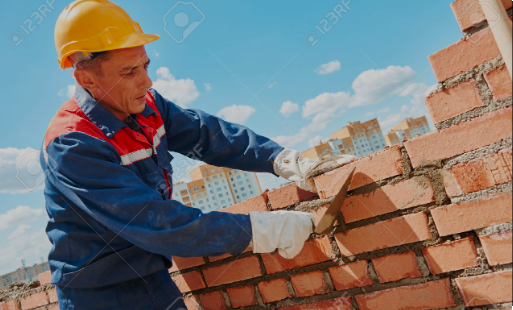
Historical Roots and Evolution of Bricklaying
1 Ancient Origins
The history of bricklaying can be traced back to ancient civilizations like Mesopotamia and the Indus Valley, where mud bricks were first used for construction. Over time, the craft evolved, and fired bricks became the preferred choice, marking a significant shift in building techniques.
2 Medieval Masonry Guilds
During the Middle Ages, the art of bricklaying and masonry was guarded by guilds. These guilds not only ensured the transmission of skills from master to apprentice but also upheld the standards of craftsmanship that defined the profession.
3 Renaissance and Architectural Revival
The Renaissance period witnessed a revival of classical architecture, leading to a surge in demand for skilled bricklayers and masons. This era saw the creation of intricate brick structures, showcasing the craftsmanship that would shape architectural landscapes for centuries to come.
Educational Pathways to Becoming a Bricklayer/Mason
1 Traditional Apprenticeships
Historically, bricklayers and masons learned their craft through apprenticeships. Aspiring artisans worked alongside experienced masters, honing their skills through hands-on experience and gradually taking on more complex tasks.
2 Formal Education and Certification
In contemporary times, formal education and certification programs have become more prevalent. These programs cover not only the practical aspects of bricklaying but also the theoretical foundations, safety protocols, and emerging trends in the construction industry.
3 Continued Professional Development
The learning journey for bricklayers and masons doesn’t end with formal education. Continuous professional development through workshops, industry seminars, and staying updated on new materials and techniques is integral to thriving in this dynamic field.
Essential Skills and Attributes of Bricklayers and Masons
1 Technical Proficiency in Bricklaying Techniques
A mastery of bricklaying techniques is at the core of this profession. From laying the first course to intricate patterns and finishes, bricklayers must possess technical proficiency in creating structures that are not only sturdy but also visually appealing.
2 Spatial Awareness and Precision
Bricklaying requires a keen sense of spatial awareness. Masons must be precise in their measurements, ensuring that each brick fits snugly into place. The ability to visualize the end result and execute with precision is a hallmark of skilled artisans.
3 Physical Stamina and Endurance
The nature of the job demands physical stamina and endurance. Bricklayers and masons often work outdoors, lifting heavy materials, and enduring the rigors of manual labor. Physical fitness is crucial for both efficiency and safety on the job.
Challenges Faced by Bricklayers and Masons
1 Weather-Related Challenges
Working outdoors exposes bricklayers and masons to the elements. Weather fluctuations, especially in extreme conditions, can pose challenges to the consistency of mortar and the overall construction process.
2 Safety Concerns and Occupational Hazards
Safety is a paramount concern in the construction industry. Bricklayers and masons work with heavy materials, power tools, and often at heights. Mitigating the risk of accidents through adherence to safety protocols is an ongoing challenge.
3 Adapting to Technological Changes
Advancements in construction technology bring new tools and methodologies. Bricklayers and masons must adapt to these changes, incorporating innovations like laser-guided tools and mechanized equipment into their traditional craft.
Innovations and Trends in Bricklaying and Masonry
1 Mechanization and Robotic Assistance
The integration of robotics and mechanized systems is transforming the construction landscape. Automated bricklaying machines and robotic assistants are becoming more prevalent, enhancing efficiency and addressing labor shortages.
2 Sustainable Building Practices
The focus on sustainable construction has influenced bricklaying and masonry. From the use of recycled materials to incorporating energy-efficient designs, artisans are contributing to eco-friendly building practices.
3 Artistic Applications and Customization
While the essence of bricklaying lies in structural integrity, there is a growing trend towards artistic applications. Intricate brick patterns, customized designs, and the use of different brick colors showcase the artistic potential within the craft.
Business Aspects of Bricklaying and Masonry
1 Independent Contracting vs. Employment
Bricklayers and masons may choose to work independently or be employed by construction firms. Independent contractors enjoy the freedom to take on diverse projects, while employed artisans benefit from job stability and consistent work.
2 Marketing and Client Acquisition
For independent contractors, effective marketing is crucial. Building a strong online presence, showcasing a portfolio of completed projects, and word-of-mouth referrals play pivotal roles in acquiring clients and securing projects.
3 Post-Completion Services and Client Satisfaction
Ensuring client satisfaction involves not just the execution of the job but also providing post-completion services. This includes addressing any issues that may arise after construction and maintaining a positive relationship with clients.
Future Prospects and Industry Dynamics
1 Augmented Reality in Masonry Design
The incorporation of augmented reality (AR) in masonry design is on the horizon. AR applications may allow artisans to visualize and plan intricate patterns before laying the first brick, enhancing precision and design capabilities.
2 Green Building Certifications
The push towards sustainable construction is likely to result in an increased demand for bricklayers and masons who are well-versed in green building practices. Achieving certifications for sustainable construction may become a valuable credential.
3 Integration of 3D Printing
While traditional bricklaying remains an art, the integration of 3D printing in construction is an emerging trend. The use of 3D-printed bricks and structures showcases the potential for technology to reshape the way buildings are constructed.
Conclusion: Building Legacies Brick by Brick
Celebrating the Craftsmanship of Bricklayers and Masons
Bricklayers and masons are the unsung artisans who contribute to the foundations of our built environment. Their craftsmanship, often overlooked, leaves a lasting legacy in the form of structures that stand the test of time.
Embracing Tradition and Embracing the Future
As the construction industry evolves, bricklayers and masons find themselves at the crossroads of tradition and innovation. Embracing new technologies while upholding the time-honored principles of their craft ensures a harmonious blend of the old and the new.







